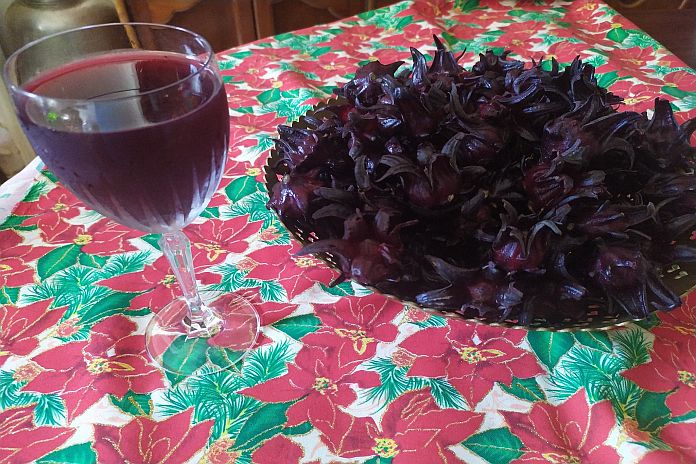By Indranie Deolall
Fragrant with warm notes of Ceylon cinnamon, pungent cloves, lacy fronds of mace, and glossy green bay leaves pulled from the potted tree that bears twinkling lights, the first sweet scent of Christmas dominated the evening air.
It lingered throughout the house for hours after, as an irresistibly fruity, tangy bouquet, drawn from a steaming potful of sorrel petals accented with grated ginger, which I inhaled deeply, prompting a surge of wonderful memories as comforting as the Caribbean custom of preparing the refreshing tart beverage each holiday season.
The aroma of Christmas may vary according to where we come from and where we now live. Yet, the soothing predictability of lingering over a simple glass of cold sorrel, steeped from the maiden batch of the fruit that my son purchased as an early surprise, meant that somehow, by observing the protocols and precautions in a pandemic year, we have managed to make it this far.

Black Sorrel
An intense wine-red that is so rich, it gives the distinct darkest variety the name, “black sorrel,” the fruit has become an annual constant that gratefully, we have never been without. The scientific title, “Hibiscus sabdariffa” indicates that it is a species of the popular garden bloom that is probably native to Africa, with some experts suggesting that the second word of the 17th-century coinage may be Jamaican or even Turkish.
Equally puzzled ethnobotanists identify the Kordofan and Darfur areas in Sudan as the likely centre of origin where it may have been domesticated about 6,000 years ago, first for its protein-rich, oily seed and later for leaf and calyx production, while others suggest South-East Asia, from north-eastern India to Malaysia. The leaves are still used as a spicy version of spinach, flavouring the famous Senegalese fish and rice dish “thieboudienne,” while in the Sahel, the fruit is commonly brewed to make a sugary herbal tea “karkade.” Young green roselle shoots, leaves and calices are cooked too, as a vegetable, in mucilaginous soups or finely cut and added to sauces, flavoured with oil, onions, dried fish and hot peppers, and eaten with tubers, cereal porridge or rice.
Jamaica and Sloane
Vegetable types were introduced to India and the Americas three centuries ago, with the Indians calling the variety we use “lal (red) ambadi.” The leaves of one strain are mixed with green chillies, salt and garlic to prepare a spicy breakfast chutney served with “jowar” (sorghum) or “bajra” (millet) and “bhakri,” a flatbread much like the Guyanese and Trinidadian “sada” roti. The variety we most favour in the region and found across the tropics, is known as Guinea/Indian/ and of course Jamaican/sorrel, but it is also called roselle, Florida cranberry, rose de ’Abyssinian, lemon bush, Natal roselle, Queensland jelly plant, sour-sour and Nigerian zobo. Truly wild plants of “Hibiscus sabdariffa” have been collected from Angola to Ghana and the Niger.
But the Caribbean country most associated with sorrel remains Jamaica, with many Mexican and other Latin American eateries referring to the famous beverage by a single telling title, “hah-my-cah.” Hans Sloane, the British son of a colonial official, who trained as a physician and botanist would spend some 15 months on the island in the late 17th-century seeking out plants for new drugs. He collected some 800 specimens including sorrel during his West Indian travels, currently held by London’s Natural History Museum. In 1707 and 1725, Sloane published his lavishly illustrated two-volume Natural History of Jamaica.
He reported, “It is planted in most gardens in this Island. The capsular leaves are made use of for making Tarts, Gellies, and Wine, to be used in fevers and hot distempers, to allay heat and quench thirst.”
High fevers and delirium
The Dutch physician and pioneer of tropical medicine, Jacobus Bontius who is known for the four-volume work “De medicina Indorum” and his 1631 book “Historiae naturalis et medicae Indiae orientalis” which introduced the word “Orang Hutan” into Western languages, mentioned the culinary and medicinal uses of the plant. He described it as growing in Java and the surrounding islands.
He wrote, “The leaves have a sour taste and are used as a relish with fat and glutinous foods. It is cooling; the Malayans, Bengalese and other Moors use it as a vegetable; . . . in high fevers and delirium it is also used.”
Perhaps the earliest reference to the roselle, accompanied by a woodcut, occurs in “Stirpium Historia,” by the Flemish botanist Matthias de L’Obel, published in 1576, with similar recorded allusions to the white-fruited variety of roselle coming from Barbados in 1750. The petals were already starring in non-alcoholic beverages and wine-making there. One pale variety is named “Archer” since it resulted from seed sent to the United States by A.S. Archer of Antigua. It is believed to be of the race grown in most gardens of Jamaica back in 1774. The juice is nearly colourless to amber.
Antioxidant and anti-cancer
Ongoing research including by the Mandeville-based Northern Caribbean University (NCU) in Jamaica has identified key medicinal qualities of the sorrel, especially as a potent antioxidant and a promising anti-cancer agent.
Findings were presented at the annual conference of the American Society for Cell Biology in 2009, the Jamaica Gleaner reported. The NCU collaborated with Loma Linda University, an Adventist institution in California, with the study showing sorrel extract inhibited oral and breast cancer cells.
A detailed doctoral dissertation submitted in 2013 to the University of Leeds’ School of Food Science and Nutrition, on the anthocyanins from “Hibiscus sabdariffa,” concluded that the long term consumption of sorrel juice, minus the added sugar may help to protect from cardiovascular disease. Anthocyanins are among the most important types of powerful plant flavonoids found in dark pigmented fruits and vegetables, with the name anthocyanin being a Greek word (antho) meaning flower and (kaynos) red or blue.
Folk medicine
Long favoured in folk medicine, it is thought that the sorrel’s positive effect is due to the high content of beneficial phenols and antioxidant activity. The paper recommended drinking 35 ml of concentrated sorrel juice or 250 ml of the diluted version daily as a nutraceutical to protect from developing high blood pressure, but warned that people with low blood pressure like me, should consume it carefully due to the hypotensive effect of the drink.
In this unprecedented year of a deadly pandemic, and with many uncertainties remaining including the likelihood we, in developing countries, may not be able to get a vaccine soon enough given all the greedy hoarding by the rich elsewhere, we can perhaps seek and find reassurance in the cycle of time, and the fact that many of us are still okay and not suffering from anosmia or the loss of smell, seen as a major symptom in a large proportion of people who get COVID-19. A recent University of Iowa study released this month, suggested that anosmia results from the initial viral infection, and damage to a type of cell that helps to support the function of neighbouring sensory neurons that detect smell. Most COVID patients recover their sense of smell, but some don’t.
Meanwhile, I will take a very deep breath of my perfumed drink, look to the night sky and raise my small glass of sorrel to the latest vaccine victory and the hope of another round of “Hibiscus sabdariffa” at Christmas.
*ID is singing “Whose sorrel now?” as she looks with dismay at countries like Canada, the United States of America, Great Britain and the European Union members, who are reserving COVID-19 vaccine doses that far outnumber their populations, as the poor nations struggle to secure any.





